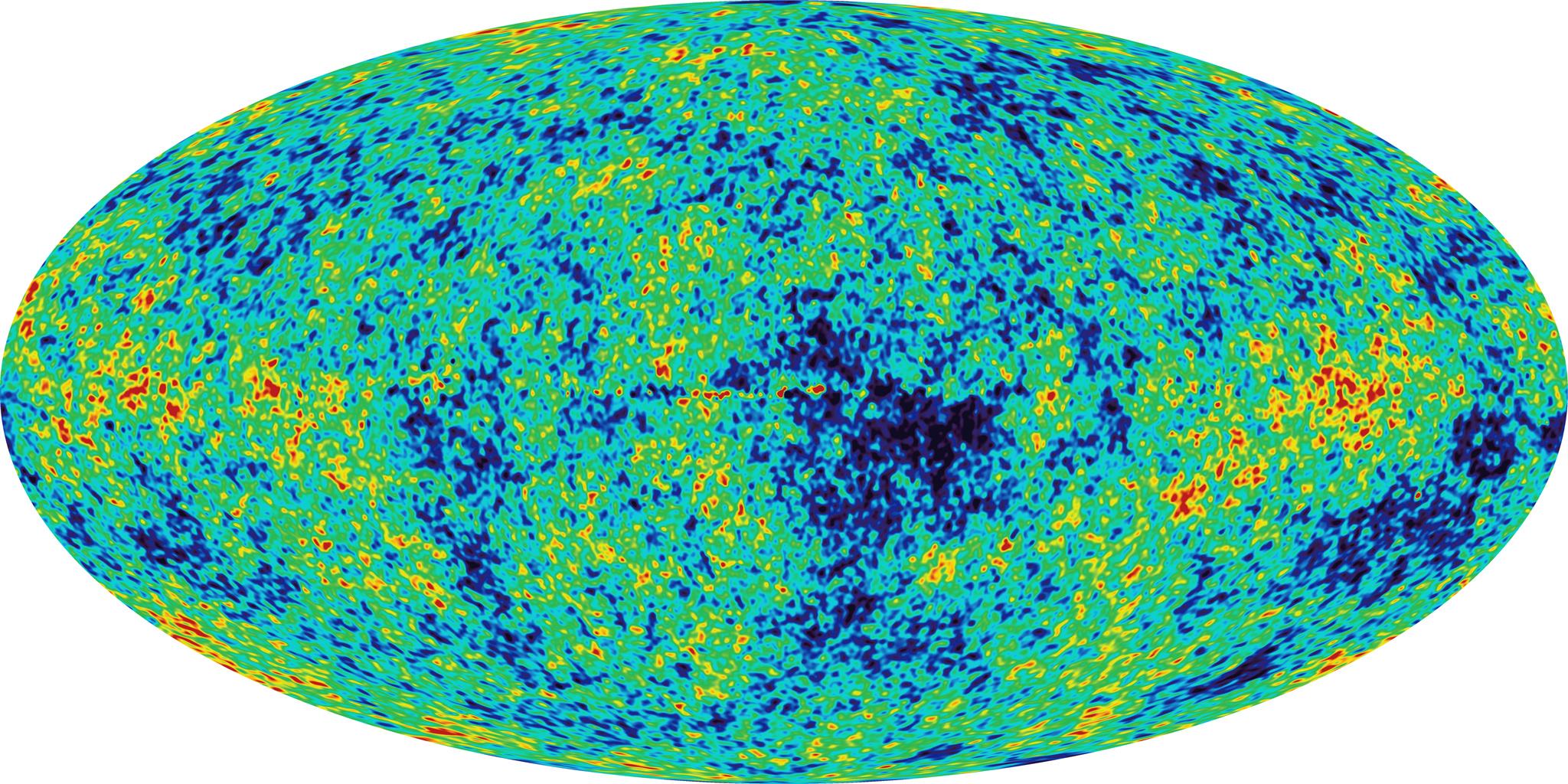
Word is that astronomers have just gotten the best, blotchy, and not particularly attractive map of the sky ever made. Now they can calculate more accurately than ever how old the universe most likely is (about 13.82 billion years instead of the previously estimated 13.73 billion years – which doesn't sound like much unless you write the difference out: ~100,000,000 years). They also can guess better what the ingredients for making the likes of us were that the Big Bang spat forth at this further but more precise time zero and other fabulous things that help us to know our place in big history.
In other words, something fairly important has happened in cosmology. A big press conference in Europe and dozens of papers submitted to the Journal of Astronomy and Astrophysics spill the beans. But it's not as though mankind just made contact with aliens, So festive as this makes many scientists the space to describe it in general media will be only so-so. And that means science reporters had some work to do in the last 24 hours. Their chore: explain what those splotches say about how matter and fields were distributed in the first tiny fractions of a second, don't get bogged down, capture the excitement with the best quotes and color available considering this news is basically from talking heads and hand-out art, throw in some history and some specs on the hardware involved. In other words, get the science correct yet understandable to the unprepared (if generally curious and alert) mind.
There is something about mottled, ovate charts of the sky's distant temperature variations that puts cosmology-minded astronomers in a froth. The first one that went big time was rendered by COBE, or Cosmic Background Explorer in the early 90s, revealing regions of the sky that varied slightly in their temperature and brightness as revealed by background microwaves left over from the cooling soup created the Big Bang birthed. Then about 11 years ago the WMAP or Wilkinson Microwave Anisotropy Probe upped the resolution in both wavelength and sky-pixel size. Just because it's interesting and not many outlets compared the new map to the previous one, the new one is at the top of this post while pasted below is the decade-old WMAP image. The difference in scale resolution is clear.
 WMAP Image.
WMAP Image.
WMAP and COBE were both NASA missions with mostly-US scientific teams. The new numbers come from an international team that, while well-peopled with Yanks, was led by the European Space Agency. It is named for German physicist Max Planck after whom constants, temperatures, and quantum limits of measurement are already named. French and Italian companies led the instrument's construction. It is about 4.2 meters high and wide. It has a mass of roughly 1950 kg or around 4300 pounds. An Ariane launcher sent it into a sort of pseudo-orbit 1.5 million km from Earth's night side, looping around a gravitational well, or Lagrangian, called L2. That was WMAP's working home and is where NASA's Webb Space Telescope is to be parked as well.
Stories:
- AP – Lori Hinnant and Seth Borenstein: Scientists Find Universe Is 80 Million Years Older ; While the news is the greater precision of the estimated age for the universe, one finds some variation among stories on just how large it is (see next bullet down for example). More important, the two AP writers start with a few such cosmic specs now known better. The term "cosmic birth certificate" is a good coinage – I'll watch to see if other outlets use the term too. There's not much on hte spacecraft, but a lot more on the scientific significance of this mission including near-verification that the universe, after it burst mysteriously into existence, underwent almost immediately (like before a few trillionths of a second immediate) a super-expansion called cosmic inflation. The AP duo consulted outside experts too. The immediate upshot is that the findings refine the general picture of the Big Bang while not challenging its fundamentals. But the story closes with speculation Planck's results might also "spin off entirely new fields of physics." One is unsure how those two points mesh. Such is deadline journalism – a story may not cohere by closing time.
- Slate/Bad Astronomy blog – Phil Plait: The Universe Is 13.82 Billion Years Old; Plait, with his specialized and especially interested audience, can get deeper into the weeds than most news writers. Plus he's an astronomer. Hence we learn that Planck does more than gather microwave background info, but microwaves from all sorts of phenomena. And, cosmic expansion, while still accelerating as has been known for 15 years or so, is a tad slower that experts had thought. There is a hint of lopsidedness to its expansion, too, a potentially profound thing if so. It looks a bit like the scale size of fluctuations is not the same around the sky. Plait takes a big breath and says just maybe hope hope hope we are seeing a palimpsest on this infant universe photo – a pre-ylem remnant or leak-through of something from before the Big Bang. Cue eerie music.
- NYTimes – Dennis Overbye: Universe as an Infant: Fatter Than Expected and Kind of Lumpy ; Ooh, nice hed. Not too ambitious, but engaging. Also, he doesnt' try to be too fine on how much older it appears to be, just "80 million to 100 million years older." He builds some narrative into the news – reporting that some of Planck's strangest results work to vindicated those who saw hints of the same things in the earlier US WMAP mission. He also traces, succinctly, the history of microwave radiation observation and their decades-long march toward the top of the pile of astronomical treasuries.
- LA Times – Amina Khan: Planck: Big Bang's afterglow reveals older universe, more matter ;
- Reuters – Irene Klotz: Universe is older than previously thought, new study shows ; Just an idle question here, one beyond anything to expect right off the bat. But if the universe is a little older than cosmologists have thought, and its expansion is speeding up as observers have noted, then why with an extra bit of time to work with has not the universe's acceleration yielded a higher expansion rate than it would have otherwisem by n0w?
- USA Today – Dan Vergano: Big Bang afermath reveals slightly older universe ;
- Christian Science Monitor – Pete Spotts: Big bang's 'afterglow' reveals universe to be a bit older, with more matter ; Nice use of an ESA illus, that AP distributed, showing the rising resolution of the COBE, WMAP, and now Planck images. He also explains how early the inflationary epoch under study occurred this way: "..some 10 nano nano nano nanoseconds after the big bang." Man-oh-nano-man, that's quick.
- Science News – Andrew Grant: Universe is a teeny bit older than thought ; Also, he writes, perhaps a bit stranger. Also here is a nice quote, perhaps from a press release or heard at the press briefing so it could be in wide circulation. One of the European leaders said the map "might look like a dirty rugby ball … but some cosmologists have given up their children to get a copy of this map." That's a good but one hopes very hyperbolic metaphor.
- LA Times – Amina Khan: Planck: Big Bang's afterglow reveals older universe, more matter ; Ah ha, she has same quote as at Science News just above, but longer and with what looks like a mis-transcription: "It might look a little bit like a dirty rugby ball or a piece of modern art. But I can assure you there are cosmologists that would have hacked our computers [methinks 'hocked' is what he might better have said and perhaps did] or maybe even given up their children to get hold of a copy of this map." This also puts the quotee at the press conference this morning (Thur). And that question I asked after reading the Reuters story above – it has answer here. Universal expansion would be going slower because it appears there is less dark energy compared to matter as had been implied by earlier observations.
- Ars Technica – Matthew Francis: First Planck results; the Universe is still weird and interesting ; Extensive discussion of the little hints of new physics in the map's asymmetry. Gets admirably techy, mentioning a multipole moment power spectrum and baryon acoustic oscillations.
- Globe and Mail – Ivan Semeniuk: New date shows universe appears to be 13.8 billion years old ;
- Independent (UK) Steve Connor: Does this picture prove the Big Bang theory? Map of "oldest light" in the Universe released, as research from Planck satellite proves cosmos is 50 million years older than previously thought." Connor, a reliable fellow, does a good job knitting things together. Too bad somebody put that execrable clunker of a headline on it. It is nonsense. First, one doubts that Connors believes or that anybody at the press conference said the data prove the older age (which, again, varies some from story to story). Astronomy is not geometry. The field may accept some things, conclude some things, but not many measurements are taken as immutably proven. Second, using the excessively confident verb "to prove" twice in one hed is just plain bad form.
- Telegraph (UK) Nick Collins: New images confirm Big Bang Theory / ..'oldest light in the universe' have confirmed the Big Ban theory but revealed new mysteries hat are not explained by current scientific models; Oh my, same problem of a tin ear for science that is noted just above in the headline at the Independent. The level of evidence for a big bank yes-or-no didn't change much at all with these observations so why write a hed implying that acceptance of that theory was in some way hanging in doubt until now? Collins story is also a little breathy in small stretches, but is on the whole a professional job.
- Guardian (UK) Ian Sample: Planck telescope maps light of the big bang scattered across the universe;
- Nature.com – Mark Peplow: Planck telscope peers into the primordial Universe ;
- BBC – Jonathan Amos: Planck satellite: Maps detail Universe's ancient light ;
Grist for the Mill: ESA Planck Website and Press Release; Planck collaboration Results Papers ; Princeton University Press Release ;


Leave a Reply